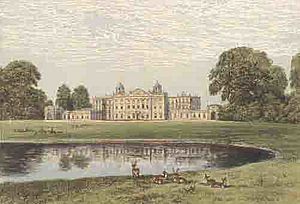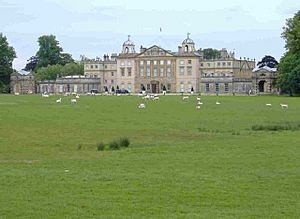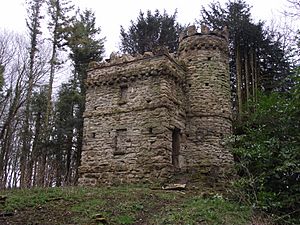Badminton House facts for kids
Badminton House is a very large country house in Badminton, Gloucestershire, England. It has been the main home of the Dukes of Beaufort since the late 1600s. The family moved here after their old home, Raglan Castle, was damaged during the English Civil War.
The house is famous because the sport of badminton got its name from here. The beautiful gardens and park around the house are also very important historically.
Contents
History
In 1612, a man named Edward Somerset bought the lands of Great and Little Badminton. These lands were mentioned in a very old record book called the Domesday Book.
Later, in the 1620s, Sir Thomas Somerset updated the old house. He added a new section with a T-shape and pointed roofs. The 3rd Duke of Beaufort then made more changes. He connected different parts of the house around a central courtyard. He also added new living areas on the east side. A grand central part was built on the north side of the house.
For the 4th Duke, an architect named William Kent updated and expanded the house. He used a style called Palladian, which was popular at the time. Many older parts of the house still remain today. The 4th Duke also helped bring a famous painter named Canaletto to England. Two of Canaletto's paintings of Badminton House are still there.
The Sport of Badminton
The sport of badminton became popular at Badminton House. Some people say it was brought back from British India. Others believe it was invented during a very cold winter in 1863. The children of the 8th Duke played a game in the Great Hall. They used a light shuttlecock that would not harm the large paintings of horses on the walls. This is how the sport got its name.
Queen Mary's Stay
Queen Mary stayed at Badminton House for much of World War II. Her staff used most of the building. This was a bit inconvenient for the Duke and Duchess of Beaufort. Later, when someone asked the Duchess where the Queen had stayed, she joked, "She lived in all of it!"
Badminton Horse Trials
Since 1949, Badminton House has been famous for the yearly Badminton Horse Trials. This is a very well-known event where horses and riders compete.
Other Connections
Badminton House is also linked to fox hunting. Many Dukes of Beaufort have led the Duke of Beaufort's Hunt. This is one of the most famous hunts in the United Kingdom.
You can book weddings and parties at Badminton House. Sometimes, houses and cottages on the estate can be rented. The estate has also been used as a filming location for movies like The Remains of the Day, 28 Days Later, and Pearl Harbor.
Next to Badminton House is the church of St Michael and All Angels. It was built in 1785. Most of the Dukes and Duchesses of Beaufort are buried there.
Park
Ragged Castle
At the end of a main road from Badminton House, there is a special building called Ragged Castle. It is a "folly," which means it was built to look like an old ruin, but it was never actually a real castle. It was built around 1750 and is now a very important historical building.
Images for kids
See also
 In Spanish: Badminton House para niños
In Spanish: Badminton House para niños






